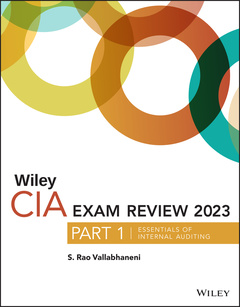Description
Wiley CIA Exam Review 2023, Part 1
Essentials of Internal Auditing
Wiley CIA Exam Review Series
Author: Vallabhaneni S. Rao
Language: English
Subject for Wiley CIA Exam Review 2023, Part 1:
Keywords
Certified internal auditor; certified internal auditor exam; certified internal auditor test; certified internal auditor exam prep; certified internal auditor test prep; certified internal auditor part 1; certified internal auditor part I; cia part 1 prep; cia 2023; 2023 essentials of internal auditing
Approximative price 69.88 €
In Print (Delivery period: 14 days).
Add to cart560 p. · 21.1x27.4 cm · Paperback
Description
/li>Contents
/li>Biography
/li>
Reduce test day anxiety with the ultimate study guide for the 2023 CIA Part 1 exam
The Wiley CIA Exam Review 2023, Part 1: Essentials of Internal Auditing prep guide delivers complete and accessible coverage of the latest Essentials of Internal Auditing exam. Organized by learning objective found on the official CIA Part 1 exam, this guide is your solution for streamlined, effective study sessions that fit within your busy schedule.
You?ll find all six domains tested on the exam, including:
- Foundations of internal auditing.
- Independence and objectivity.
- Proficiency and due professional care.
- Quality assurance and improvement programs.
- Governance, risk management, and control.
- Fraud risks.
Designed to help you retain and synthesize key exam material, the Wiley CIA Exam Review 2023, Part 1: Essentials of Internal Auditing is the go-to resource for candidates preparing for the challenging Part 1 exam.
Preface ix
CIA Exam Content Syllabus and Specifications xiii
CIA Exam-Taking Tips xvii
Professional Standards 1
i. 1 New IPPF Defined 2
i. 2 Introduction to the IIA’s Standards 2
i. 3 IIA’s International Standards 4
Domain 1 Foundations of Internal Auditing 57
1.1 Mission of Internal Audit 57
1.2 Definition of Internal Auditing 58
1.3 Core Principles 60
1.4 Internal Audit Charter 63
1.5 Types of Audit Services 66
1.6 IIA’s Code of Ethics 67
1.7 Roles and Responsibilities of Management 69
1.8 Sample Practice Questions 72
Domain 2 Independence and Objectivity 75
2.1 Independence Defined 75
2.2 Factors Threatening and Supporting Independence 77
2.3 Objectivity Defined 81
2.4 Factors Threatening and Supporting Objectivity 82
2.5 Policies to Promote Objectivity 87
2.6 Sample Practice Questions 89
Domain 3 Proficiency and Due Professional Care 91
3.1 Proficiency and Competency Defined 91
3.2 Due Professional Care Defined 93
3.3 Continuing Professional Development 94
3.4 Professional Judgment and Competence 95
3.5 Competency Levels for Internal Auditors 96
3.6 Sample Practice Questions 104
Domain 4 Quality Assurance and Improvement Program 107
4.1 Required Elements 107
4.2 Reporting Requirements 110
4.3 Conformance versus Nonconformance 111
4.4 TQM in Internal Audit Operations 112
4.5 Sample Practice Questions 114
Domain 5 Governance, Risk Management, and Control 117
5.1 Governance Principles, Components, and Problems 118
5.2 Governance Models and Frameworks 130
5.3 Roles of the Board of Directors 140
5.4 Characteristics of Effective and Ineffective Boards 151
5.5 Roles of Executives and Officers 157
5.6 Roles of the Audit Committee 173
5.7 Roles of Board‐Level Committees 176
5.8 Roles of Shareholders and Stakeholders 183
5.9 Scope of Board‐Level Audits 188
5.10 Organizational Culture 202
5.11 Organizational Ethics 211
5.12 Corporate Social Responsibility 229
5.13 Risk Concepts, Risk Types, and Risk Management Processes 235
5.14 Globally Accepted Risk Management Frameworks 264
5.15 Effectiveness of Risk Management 287
5.16 Internal Audit’s Role in the Risk Management Process 291
5.17 Internal Control Concepts and Types of Controls 294
5.18 Globally Accepted Internal Control Frameworks 328
5.19 Effectiveness and Efficiency of Internal Controls 345
5.20 Compliance Management 349
5.21 Sample Practice Questions 355
Domain 6 Fraud Risks 361
6.1 Interpretation of Fraud Risks 362
6.2 Types of Fraud 368
6.3 Indicators of Fraud 380
6.4 Awareness of Fraud 388
6.5 Controls to Prevent or Detect Fraud Risks 389
6.6 Audit Tests to Detect Fraud, Including Discovery Sampling 392
6.7 Integrating Analytical Relationships to Detect Fraud 401
6.8 Interrogation or Investigative Techniques 411
6.9 Forensic Auditing and Computer Forensics 420
6.10 Use of Computers in Analyzing Data for Fraud and Crime 425
6.11 GAO’s Framework for Managing Fraud Risks 429
6.12 COSO’s Framework for Fraud Risk Management 432
6.13 Fraud Analytics 434
6.14 Fraud and the Internal Auditor 439
6.15 Sample Practice Questions 440
Sample Practice Questions, Answers and Explanations 443
Appendix A: Characteristics of Effective Auditors and Audit Function 475
Appendix B: Big Data and Data Mining 483
About the Author 511
Index 513
S. RAO VALLABHANENI is an educator, author, publisher, consultant, and practitioner in business with more than thirty years of management and teaching experience in auditing, accounting, manufacturing, and IT consulting in both public and private sectors. He is the author of more than sixty trade books, study guides, review guides, monographs, audit guides, and articles in auditing and IT. He holds twenty-four professional certifications in business management in Accounting, Auditing, Finance, Information Technology, Manufacturing, Quality, and Human Resource.




